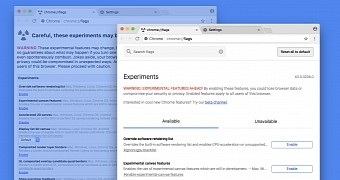Chromium evangelist François Beaufort shares today on his Google+ page news about Google's Chrome team working on redesigning the internal chrome://flags page with a bunch of cool new features and improvements.
The chrome://flags page is used to enable experimental features in the Google Chrome web browser, as well as in Chrome OS, the Linux-based operating system that powers Chromebooks. In the latest Chrome Canary build, the chrome://flags page was revamped with a neat list of interesting changes.
For example, there's now a tabbed interface to separate the "Available" and "Unavailable" flags, Chrome's version number is now displayed on the page, the warning blurb was simplified, both the typography and color scheme were modernized, and support for larger touch targets was implemented.
Better support for mobile devices
The new design of the chrome://flags page is also aimed at mobile devices, as Google's Chrome engineers are working to improve its responsiveness on this type of devices, be it mobile phones, tablets, or convertibles (e.g. 2 in 1 laptops). This is probably done because Google recently launched the Pixelbook.
Lastly, filtering was improved to offer users a better search experience on mobile devices, thanks to the implementation of a page flag search functionality. But more, smaller changes could be done in the coming weeks to the chrome://flags page to modernize it, until it hits the stable channels for Chrome OS users.
If you can't wait until then, you can give it a try right now by switching to the Chrome Canary experimental channel on your Chromebook, but please be aware that it's "experimental" for a reason, and your Chrome OS experience won't be as stable and reliable as it should be if you were running the stable build. The Canary channel has a lot more other goodies that you could try out on your Chromebook.

 14 DAY TRIAL //
14 DAY TRIAL //